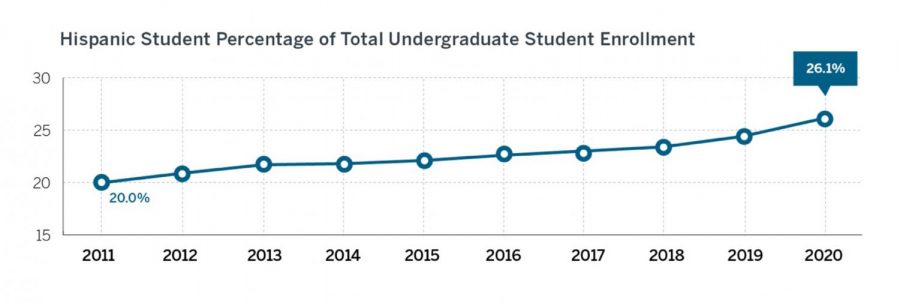UT-Austin increases Hispanic undergraduate enrollment, retains Hispanic-Serving Institution qualification
September 29, 2021
UT’s Hispanic undergraduate population increased for the second year in a row, reaching an all-time high and allowing the University to retain its Hispanic-Serving Institution qualification, according to a Sept. 20 press release.
The percentage of Hispanic undergraduate students enrolled at UT jumped from about 26.1% to 27.1% since 2020, according to the release. The University first qualified as a Hispanic-Serving Institution last year after it exceeded the 25% Hispanic undergraduate student enrollment threshold and now has over 10,800 Hispanic undergraduate students.
Miguel Wasielewski, executive director of admissions, said the statistic is a reflection of outreach initiatives for Hispanic students by the admissions office. Wasielewski said the admissions team reached more prospective Hispanic students than in previous years because COVID-19 pushed many events online.
“As we see representation of students increase here on campus, I think it’s a very positive thing for everybody,” Wasielewski said. “Anytime you can interact with people that come from diverse backgrounds that have different ideas and thoughts and experiences, that makes the education better for everybody.”
Brian Dixon, associate vice provost of student aid and affordability, said national studies show that Latinx students are hindered at a higher rate by tuition payments and additional college expenses compared to some other students. Dixon said UT is becoming more attainable for lower-income students through initiatives such as the Texas Advance Commitment, which gives tuition money to students whose families make less than $65,000 a year.
“We’ve entered a major partnership with the Dell Foundation, where we offer grants, laptops and computers to students,” Dixon said. “(Texas Advance Commitment and the Dell Foundation partnership) are two of the more significant programs that we have put in place so that students have a lot of sufficient money to be able to go to school.”
Government junior Nick Herrera said the rise in Hispanic enrollment shocked him.
“Campus looks like it’s getting whiter,” Herrera said. “I don’t know, maybe that’s just because I was really upset whenever I first went to UT because I had this idea that it was gonna be super diverse.”
Biology junior Teresa Martinez said she is worried about how the University will accommodate the increase of Latinx students.
“I think UT could do a better job with making everyone feel included,” Martinez said. “(However), this is a good turning point and it doesn’t have to end here.”



